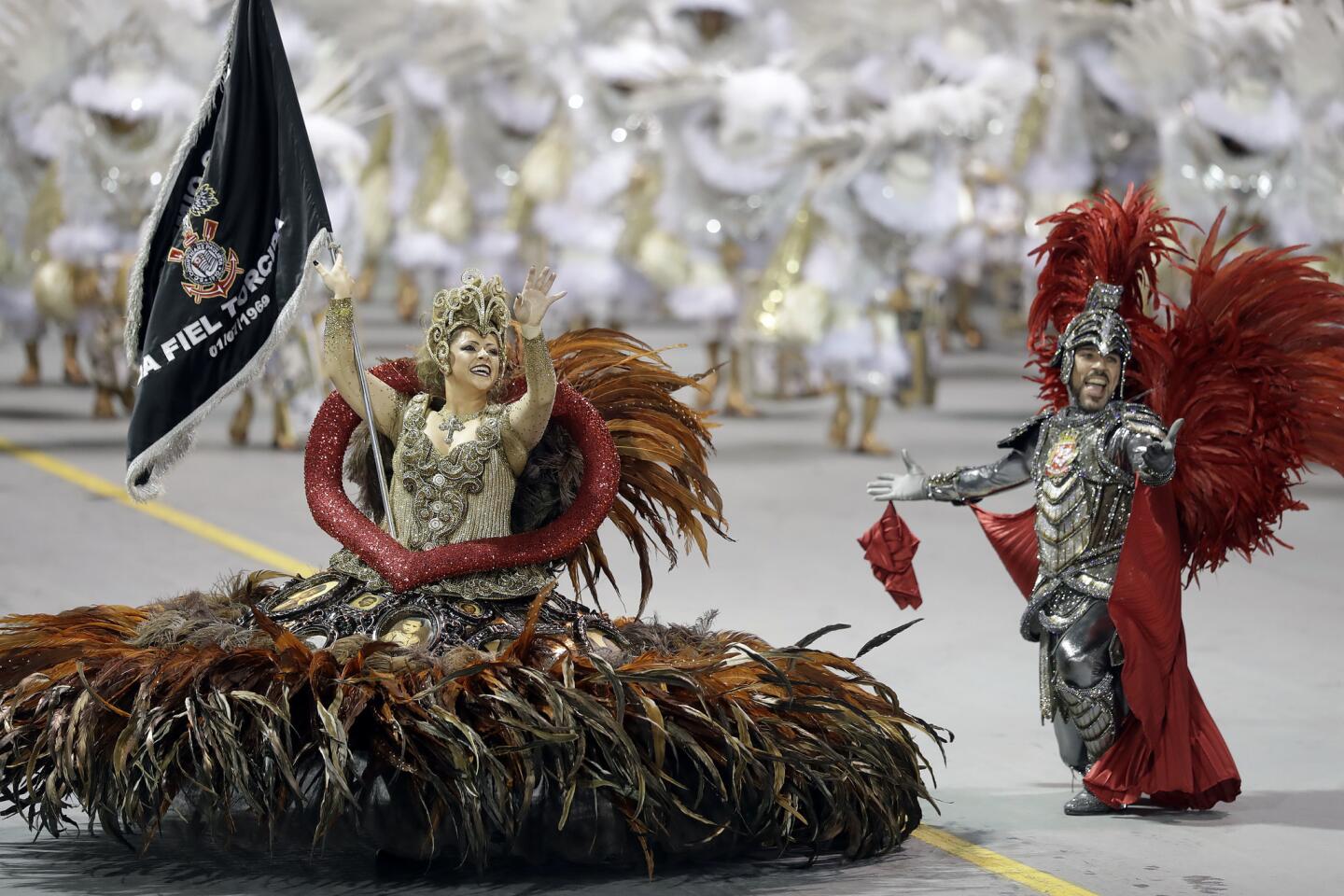Brazil goes a little less wild for this year’s Carnival
Reporting from Sao Paulo, Brazil — When Erika Moura made her debut as Brazil’s Carnival muse in 2015, she wore nothing but strategically placed swirls of glitter paint and matching heels as she sambaed across TV screens to promote the annual celebration for the country’s biggest broadcaster, Globo.
This year, the station has done an about-face, dressing the muse it calls the Globeleza — a combination of its name and the Portuguese word for beauty — in more demure Carnival costumes that represent the country’s numerous local celebrations.
The piece also shows the 24-year-old, who got her start in Sao Paulo’s parades with the Mocidade Alegre samba school, dancing alongside performers who represent Brazil’s racial diversity and regional differences.
This shift in Carnival culture came as a surprise for many Brazilians, although not an unwelcome one. Some chalk it up to Brazil’s moves toward a more conservative society, citing voting patterns in its most recent municipal elections and the growing number of evangelical Christians in the country. Others say it’s a sign that Brazil is becoming more conscientious of its multiculturalism and its roots.
Patricia da Silva Souza, a 27-year-old office assistant who was heading out with her girlfriends Saturday night to celebrate Carnival at one of Sao Paulo’s street parties, said she loved Globeleza’s new look.
“It is much more creative and inclusive,” she said. “They put in other representations of Carnival too, not just what it looks like in Rio. It finally shows what Carnival is all about, and that’s not just body paint and glitter.”

Every year since Globeleza was created in 1990, a black woman has been chosen to dance partially nude for viewers, leading to accusations that Globo was objectifying black women and perpetuating a stereotype that they are there only to entertain others.
“I think the change is very positive, because it alters the way black women are represented by Carnival,” said Claudia Adao, a researcher at the University of Sao Paulo who studies violence against black youth and has participated in the city’s parades as a flag bearer.
“It calls into question the objectification of black women and the perspective that we are just sexual symbols, and shows that black women can be represented in other ways.”
The Globeleza says she never saw the videos as objectifying black women — or women in general — but rather looks at her role with an “artistic eye.”
“Ever since I watched the vignettes as a viewer, I was enchanted with the talent of the dancers,” Moura said in an email.
Despite all the criticism, Globo maintains that its casting decisions were never based on race.
“The characteristics that we take into consideration when choosing the dancer who will represent Globeleza’s Carnival are her charisma, grace and talent,” said Sergio Valente, that station’s communications director and co-creative director of the promotional video. “Globo has a historical and permanent positive action plan against all forms of prejudice.”
He cited Globo’s collaboration with several United Nations organizations, including U.N. Women, as an example of how the station is fighting “discrimination against vulnerable populations.”
While the culture of Carnival may be starting to change, there were still plenty of scantily-clad dancers out in the streets as the five-day festivities got under way in Sao Paulo on Friday night.
This year’s Carnival isn’t expected to be quite as elaborate as in years gone by. Brazil’s economic crisis has taken a toll on the funds allotted to celebrations across the country.
Finance Minister Henrique Meirelles recently declared the recession over, but said “we still live with the consequences of it in many respects.”
In Sao Paulo, Brazil’s largest city, a new mayor who made his name in business has slashed the city Ministry of Culture’s budget by more than 43%. Other departments have also experienced budget cuts, including education (28%), healthcare (21%) and the environment (44%).
The city has reduced the prize money that will be handed out to the Carnival court. This year’s king and queen will each receive 2,000 reais ($642), down from from last year’s 20,000 reais ($6,427). Those receiving prizes in a category that pays homage to the samba schools’ longest-standing members will receive 1,000 reais ($321), as opposed to the 8,000 reais ($2,571) they were given in 2016.
The city of Rio de Janeiro declared itself in a state of financial emergency last year when it could no longer pay its employees on time, leading to violent protests by public servants who were afraid of losing their homes and not being able to feed their families.
The city is expecting fewer visitors during this year’s Carnival, as cash-strapped Brazilians cut back on travel. That will hurt the hotel and tourism sectors.
The city of Parnamirim, in the northeastern state of Rio Grande do Norte, cut its Carnival budget by more than half, saying there were other budget priorities. Olinda, a coastal town in northeastern Pernambuco state known for its street parties, giant papier-mâché dolls and frevo music, also halved its Carnival budget, despite a reputation for putting on one of Brazil’s most traditional celebrations.
Other cities canceled their celebrations altogether. Nova Lima, in the southeastern state of Minas Gerais, said it needs the money for basic services like healthcare, infrastructure, security and education. Capivari, located in the state of Sao Paulo, also wants to invest in healthcare, particularly the prevention of dengue fever.
But for all the financial woes, Brazilian revelers are still managing to enjoy the festivities and celebrate the changes to the culture of Carnival and the Globeleza.
The parties might be smaller this year, but many Brazilians feel more pride than ever now that their muse has become more representative of the nation as a whole.
Langlois is a special correspondent.
ALSO
In Brazil, Carnival-goers won’t let Zika or economic woes ruin the party
Brazil deploys 220,000 troops to battle Zika mosquitoes
17 Mardi Gras recipes for king cake, gumbo and more
More to Read
Sign up for Essential California
The most important California stories and recommendations in your inbox every morning.
You may occasionally receive promotional content from the Los Angeles Times.













